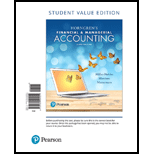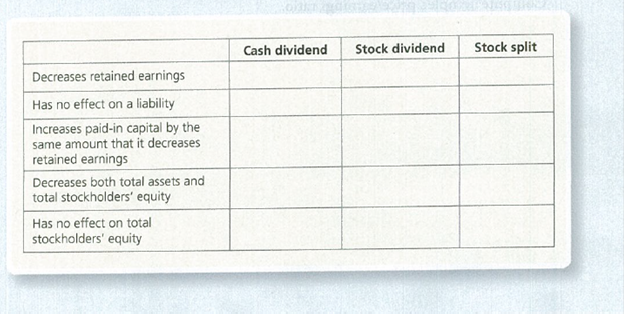
Horngren's Financial & Managerial Accounting, Student Value Edition Plus MyLab Accounting with Pearson eText -- Access Card Package (6th Edition)
6th Edition
ISBN: 9780134642857
Author: Tracie L. Miller-Nobles, Brenda L. Mattison, Ella Mae Matsumura
Publisher: PEARSON
expand_more
expand_more
format_list_bulleted
Concept explainers
Textbook Question
Chapter 13, Problem 13.32E
Determining the effects of cash dividends, stock dividends, and stock splits
Complete the following chart by inserting a check mark (√) for each statement that is true.

Expert Solution & Answer
Want to see the full answer?
Check out a sample textbook solution
Students have asked these similar questions
For each of the transactions above, indicate the amount of the adjusting entry on the elements of the balance sheet and income statement.Note: Enter negative amounts with a minus sign.
Need help with this question solution general accounting
Don't use ai given answer accounting questions
Chapter 13 Solutions
Horngren's Financial & Managerial Accounting, Student Value Edition Plus MyLab Accounting with Pearson eText -- Access Card Package (6th Edition)
Ch. 13 - Prob. 1QCCh. 13 - Prob. 2QCCh. 13 - Suppose Value Home and Garden Imports issued...Ch. 13 - Prob. 4QCCh. 13 - Prob. 5QCCh. 13 - Assume that a company paid 6 per share to purchase...Ch. 13 - Prob. 7QCCh. 13 - A small stock dividend a. decreases common stock....Ch. 13 - Prob. 9QCCh. 13 - Jackson Health Foods has 8,000 shares of 2 par...
Ch. 13 - Prob. 11QCCh. 13 - Prob. 1RQCh. 13 - Prob. 2RQCh. 13 - How does authorized stock differ from outstanding...Ch. 13 - What are the four basic rights of stockholders?Ch. 13 - How does preferred stock differ from common stock?Ch. 13 - Prob. 6RQCh. 13 - What are the two basic sources of stockholders'...Ch. 13 - Prob. 8RQCh. 13 - If stock is issued for assets other than cash,...Ch. 13 - Prob. 10RQCh. 13 - Where and how is treasury stock reported on the...Ch. 13 - What is the effect on the accounting equation when...Ch. 13 - What are the three relevant dates involving cash...Ch. 13 - How does cumulative preferred stock differ from...Ch. 13 - What is a stock dividend?Ch. 13 - Prob. 16RQCh. 13 - What are some reasons corporations issue stock...Ch. 13 - Prob. 18RQCh. 13 - Prob. 19RQCh. 13 - What does the statement of retained earnings...Ch. 13 - What is a prior-period adjustment?Ch. 13 - Prob. 22RQCh. 13 - What does earnings per share report, and how is it...Ch. 13 - What is the price/earnings ratio, and how is it...Ch. 13 - What does the rate of return on common stock show,...Ch. 13 - Prob. 13.1SECh. 13 - Prob. 13.2SECh. 13 - Prob. 13.3SECh. 13 - Prob. 13.4SECh. 13 - Prob. 13.5SECh. 13 - Prob. 13.6SECh. 13 - Prob. 13.7SECh. 13 - S13-8 Dividing cash dividends between preferred...Ch. 13 - Prob. 13.9SECh. 13 - Prob. 13.10SECh. 13 - Prob. 13.11SECh. 13 - Prob. 13.12SECh. 13 - Prob. 13.13SECh. 13 - Prob. 13.14SECh. 13 - Prob. 13.15SECh. 13 - Prob. 13.16SECh. 13 - Prob. 13.17SECh. 13 - Prob. 13.18SECh. 13 - Prob. 13.19ECh. 13 - Prob. 13.20ECh. 13 - Prob. 13.21ECh. 13 - Prob. 13.22ECh. 13 - Prob. 13.23ECh. 13 - Prob. 13.24ECh. 13 - Prob. 13.25ECh. 13 - Prob. 13.26ECh. 13 - Prob. 13.27ECh. 13 - Prob. 13.28ECh. 13 - Prob. 13.29ECh. 13 - Prob. 13.30ECh. 13 - Prob. 13.31ECh. 13 - Determining the effects of cash dividends, stock...Ch. 13 - Prob. 13.33ECh. 13 - Prob. 13.34ECh. 13 - Prob. 13.35ECh. 13 - Prob. 13.36ECh. 13 - Prob. 13.37ECh. 13 - Prob. 13.38ECh. 13 - P13-39A Organizing a corporation and issuing...Ch. 13 - Prob. 13.40APCh. 13 - Prob. 13.41APCh. 13 - Prob. 13.42APCh. 13 - P13-43A Preparing an income statement
The...Ch. 13 - Prob. 13.44APCh. 13 - Prob. 13.45APCh. 13 - Prob. 13.46BPCh. 13 - Prob. 13.47BPCh. 13 - Prob. 13.48BPCh. 13 - Prob. 13.49BPCh. 13 - Prob. 13.50BPCh. 13 - Prob. 13.51BPCh. 13 - Prob. 13.52BPCh. 13 - Prob. 54CPCh. 13 - Prob. 13.1COPCh. 13 - Prob. 13.1TICh. 13 - Prob. 13.1FSCCh. 13 - Prob. 13.1CA
Knowledge Booster
Learn more about
Need a deep-dive on the concept behind this application? Look no further. Learn more about this topic, accounting and related others by exploring similar questions and additional content below.Similar questions
- I want to correct answer general accounting questionarrow_forwardKindly help me with accounting questionsarrow_forwardDuo Corporation is evaluating a project with the following cash flows: Year 0 1 2 3 Cash Flow -$ 30,000 12,200 14,900 16,800 4 5 13,900 -10,400 The company uses an interest rate of 8 percent on all of its projects. a. Calculate the MIRR of the project using the discounting approach. Note: Do not round intermediate calculations and enter your answer as a percent rounded to 2 decimal places, e.g., 32.16. b. Calculate the MIRR of the project using the reinvestment approach. Note: Do not round intermediate calculations and enter your answer as a percent rounded to 2 decimal places, e.g., 32.16. c. Calculate the MIRR of the project using the combination approach. Note: Do not round intermediate calculations and enter your answer as a percent rounded to 2 decimal places, e.g., 32.16. a. Discounting approach MIRR b. Reinvestment approach MIRR c. Combination approach MIRR % % %arrow_forward
- Provide correct answer general accounting questionarrow_forwardNeed help with this question solution general accountingarrow_forwardConsider a four-year project with the following information: Initial fixed asset investment = $555,000; straight-line depreciation to zero over the four-year life; zero salvage value; price = $37; variable costs = $25; fixed costs = $230,000; quantity sold = 79,000 units; tax rate = 24 percent. How sensitive is OCF to changes in quantity sold?arrow_forward
- Light emitting diodes (LED) light bulbs have become required in recent years, but do they make financial sense? Suppose a typical 60-watt incandescent light bulb costs $.39 and lasts 1,000 hours. A 15-watt LED, which provides the same light, costs $3.10 and lasts for 12,000 hours. A kilowatt-hour of electricity costs $.115. A kilowatt-hour is 1,000 watts for 1 hour. If you require a return of 11 percent and use a light fixture 500 hours per year, what is the equivalent annual cost of each light bulb? Note: A negative answer should be indicated by a minus sign. Do not round intermediate calculations and round your answers to 2 decimal places, e.g., 32.16.arrow_forwardRecently, Abercrombie & Fitch has been implementing a turnaround strategy since its sales had been falling for the past few years (11% decrease in 2014, 8% in 2015, and just 3% in 2016.) One part of Abercrombie's new strategy has been to abandon its logo-adorned merchandise, replacing it with a subtler look. Abercrombie wrote down $20.6 million of inventory, including logo-adorned merchandise, during the year ending January 30, 2016. Some of this inventory dated back to late 2013. The write-down was net of the amount it would be able to recover selling the inventory at a discount. The write-down is significant; Abercrombie's reported net income after this write-down was $35.6 million. Interestingly, Abercrombie excluded the inventory write-down from its non-GAAP income measures presented to investors; GAAP earnings were also included in the same report. Question: From an investor standpoint, do you think that the effect of the inventory write-down should be considered when…arrow_forwardFinancial accountingarrow_forward
arrow_back_ios
SEE MORE QUESTIONS
arrow_forward_ios
Recommended textbooks for you
 College Accounting, Chapters 1-27AccountingISBN:9781337794756Author:HEINTZ, James A.Publisher:Cengage Learning,
College Accounting, Chapters 1-27AccountingISBN:9781337794756Author:HEINTZ, James A.Publisher:Cengage Learning, Financial Reporting, Financial Statement Analysis...FinanceISBN:9781285190907Author:James M. Wahlen, Stephen P. Baginski, Mark BradshawPublisher:Cengage LearningPrinciples of Accounting Volume 1AccountingISBN:9781947172685Author:OpenStaxPublisher:OpenStax College
Financial Reporting, Financial Statement Analysis...FinanceISBN:9781285190907Author:James M. Wahlen, Stephen P. Baginski, Mark BradshawPublisher:Cengage LearningPrinciples of Accounting Volume 1AccountingISBN:9781947172685Author:OpenStaxPublisher:OpenStax College

College Accounting, Chapters 1-27
Accounting
ISBN:9781337794756
Author:HEINTZ, James A.
Publisher:Cengage Learning,

Financial Reporting, Financial Statement Analysis...
Finance
ISBN:9781285190907
Author:James M. Wahlen, Stephen P. Baginski, Mark Bradshaw
Publisher:Cengage Learning

Principles of Accounting Volume 1
Accounting
ISBN:9781947172685
Author:OpenStax
Publisher:OpenStax College
Dividend disocunt model (DDM); Author: Edspira;https://www.youtube.com/watch?v=TlH3_iOHX3s;License: Standard YouTube License, CC-BY